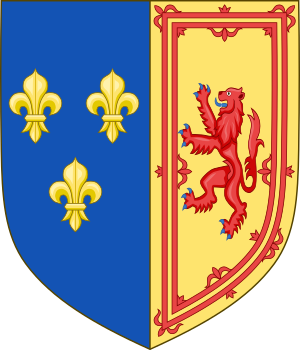Treaty of Edinburgh facts for kids
The Treaty of Edinburgh (also called the Treaty of Leith) was an important agreement signed on July 5, 1560. It was made between Queen Elizabeth I of England and the Scottish Protestant leaders (called the Lords of the Congregation). They signed it with representatives from King Francis II of France, who was married to Mary Queen of Scots.
This treaty officially ended the siege of Leith. It also aimed to replace the old friendship between Scotland and France (known as the Auld Alliance) with a new agreement between England and Scotland. The treaty also helped keep the peace between England and France, which had been agreed upon earlier in the Treaty of Cateau-Cambrésis.
Contents
French and English Troops in Scotland
At this time, Mary of Guise ruled Scotland. She was supported by French soldiers. However, Scottish Protestants disagreed with her rule during a time called the Reformation Crisis.
During the Siege of Leith, French troops built up defenses in the town and port of Leith. An English and Scottish Protestant army attacked them. The English army had been invited into Scotland by the Scottish lords through the Treaty of Berwick.
The Treaty of Edinburgh was signed just a month after Mary of Guise died. After the treaty, the defenses at Leith, Inchkeith, and Dunbar Castle were taken down. All the French soldiers then left Scotland.
In 2006, parts of an old fort used during the siege were found in Edinburgh's Pilrig Park. You can also see two old cannon spots on Leith Links today.
What the Treaty Said
Important people from France and England met to discuss the treaty. For France, there was Jean de Monluc, a bishop, and Charles de la Rochefoucault. For England, there was William Cecil and Nicholas Wotton.
The French also talked with Scottish leaders like the Archbishop of St Andrews and William Maitland. These Scottish leaders represented the Lords of the Congregation.
During the talks, fighting stopped. Two cannon shots from Edinburgh Castle marked this peace on June 17.
The main agreements were:
- All French and English soldiers and ships would leave Scotland.
- Mary, Queen of Scots, and her husband, King Francis II of France, would stop using the royal symbols of England and Ireland in their family crests. This meant they would not claim to be the rulers of England.
- Mary and Francis would accept the requests made by the Scottish nobles and people on July 6, 1560.
Why the Treaty Wasn't Approved
Sometimes, people confuse this treaty with the laws passed by the Reformation Parliament in August 1560. That parliament worked to set up the Protestant church in Scotland.
However, Mary, Queen of Scots, never officially approved (or ratified) the Treaty of Edinburgh. Even though many people pressured her to do so until 1567, she refused.
Despite not being ratified, the treaty still worked. French troops left Scotland, and the Roman Catholic Church eventually lost its power in Scotland.
Mary likely didn't want to approve the treaty for a few reasons:
- She loved France very much. She had been the queen of France.
- She saw the Scottish Lords of the Congregation as rebels against her mother, Mary of Guise.
- The treaty officially said Elizabeth was the Queen of England. Mary wanted to be the Queen of England herself.
Later, in April 1583, a group called the Gowrie Regime tried to get the treaty approved.
See also
- List of treaties



